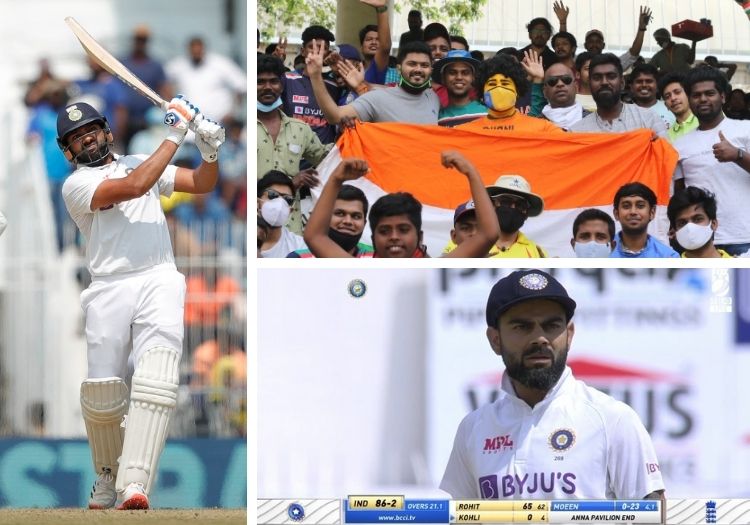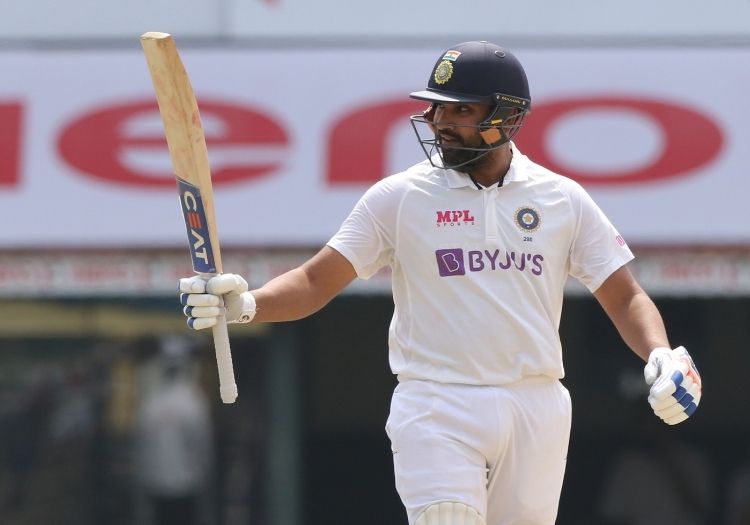SAM MORSHEAD takes a look back at the action on the first day of the second Test between India and England in Chennai...

India v England: 2nd Test scorecard
England have review reinstated after umpire error
Chennai (day 1 of 5: India 300-6)
Rohit and the power of the white ball
How often in our sport do we hear complaints of one format infecting another.
White-ball cricket, and specifically T20, is freely blamed for the nature of batsmen’s dismissals against the red ball, perceived impatience in multi-day matches, and all manner of other ills.
It is lazy criticism, often fallible under scrutiny, based more on nostalgia and sentiment than any semblance of evidence. And in this series, we have now had two prime examples of how the shorter forms have influenced their red-ball cousin for the better.
Twice in two matches, Indian batsmen brought up on limited-overs fare have delivered timely and technically exceptional innings - Rishabh Pant’s assault on Jack Leach a week ago and now a magnificent hundred from Rohit Sharma.
On a surface that was exploding with life from the first half-hour of the game, the Indian opener never looked flustered, as he chose to counter the pitch’s threat with combative strokeplay.
An old-fashioned approach to the environment at the Chepauk on Saturday would only have dug Rohit and by extension India into trouble. Instead, he trusted his instinct and ability - just as Pant had done in counter-attacking against Leach - and boy did it pay off.
Playing spin well in front of his body, and happy to hit out of the rough, Rohit rollicked along at a run-a-ball in the first session while his teammates scratched and scraped around him.
Rohit moved from 20 to 40 in just 13 balls, and by lunch had 80 of the 106 the home side had managed in a frenetic and fabulous session.
Then, as India contemplated the cheap dismissal of Virat Kohli, he effortlessly toned down his approach after the interval, consolidating with Ajinkya Rahane while occasionally reminding England that he could shift from second to sixth in an instant - as one steepling straight six off Moeen, at the end of a balletic shuffle, illustrated perfectly.
A little less than an hour before tea, Rohit paddle swept Moeen for two to fine leg to complete his seventh Test century. All have come in India - where he naturally looks much more at ease - but few can have been on pitches that were quite as challenging.
Eventually he was dismissed, but his 161 runs had been accumulated not in 'traditional' Test style but in the manner we are so used to seeing against the white ball.
It was the perfect blend of innovation, aggression and composure, and only possible because of the influence of short-format cricket.

Rohit Sharma was magnificent on day one in Chennai
Kohli gets his wish
We were promised a raging turner in Chennai, and the Chepauk curators - perhaps with the words of India’s captain ringing in their ears - delivered on that pledge.
Virat Kohli had lamented the lethargic nature of the playing surface provided for the first game of the series in the aftermath of his side’s defeat.
"The reality of the situation is that the pitch was very flat and slow," he said.
"I'm not saying that as an excuse and that we will hold onto as a team. But you have to understand the reality of what went on.
"That was the case in the first two days, even day three when the wicket really started to change. Before that it was a really flat and slow pitch.”
When Kohli speaks, India’s cricket community listens, and therefore - perhaps inevitably - it was clear very early in this Test match that the strip was going to be a considerably different challenge.
Mark Butcher, the former England international who is in Chennai on commentary duty for the world feed, summed it up perfectly.
“Sometimes (doing the pitch report before the first day’s play) is like opening up a book for the blind, with all of the braille. Today it was like opening a kid’s book, with all the big letters.”
And so it came to pass.
Rough started forming in the footmarks of Stuart Broad and Olly Stone within three overs, and inside the first half-hour balls were exploding out of the pitch.
Both Jack Leach and Moeen Ali found substantial turn, while the wicket also appeared a little two-faced, with the ball occasionally getting stuck and leaving the batsmen well through their shots.
And as India’s fourth-wicket pair compiled a century stand during the afternoon session, it became increasingly obvious that winning the toss and batting first was considerably more important on this track than it was in the first Test.
The average first-innings total in Tests at the Chepauk is 344. On this evidence, statistical par would be worth much more, especially with Ravichandran Ashwin and the enigmatic Kuldeep Yadav in reserve for India.
Kohli had his wish, and despite England's rally towards the end of the day, India have the upper hand.
Three cheers for the return of fans
How good it was to hear cricket’s authentic backing track underscoring the action once again.
Fans were allowed into the Chepauk, having been kept outside during the first Test for Covid-19 reasons, and even to a TV viewer 5,000 miles away the improvement in atmosphere was palpable.
For nine months, we have become all too used to canned crowd noise - monotonous hums and out-of-sync cheers, designed by sound engineers to act as some sort of comfort blanket, shielding our viewing experience from the world we currently inhabit.
In some cases it has worked, in others it has felt wholly empty, occasionally it has been just plain daft; but, slowly and surely, we are beginning to see a return to what we once knew.
It will take some time for stadiums to fill to 100 per cent capacity - and there would have been no guarantee of a full house for this clash even had it been possible - but fill they will, one day.
And after our experiences of the past year, we will cherish those sounds even more. The random horns, the collective gasp of admiration, the echoey hollow of shock - never more poignant than when Virat Kohli was bowled through the gate by Moeen Ali on the first morning.
Great sporting moments are created by athletes, but when they take place in a vacuum their majesty is undermined.
Watching England play cricket, even on TV, felt normal again today.
And that, even despite the contradiction that means England’s players must operate in a bio-secure bubble while they perform in front of thousands of intermingling fans, is reason to celebrate.

Moeen Ali celebrates the dismissal of Virat Kohli
Leach: A man for all conditions
In the days preceding this game, the contrast in Jack Leach’s first and second-innings performances in Tests came into sharp focus.
Leach, a key cog in England’s exceptional win in Chennai earlier in the week, had 50 wickets from 13 caps going into the second match of the series, the vast majority of which - 36 - have come in his side’s second effort with the ball.
His first-innings average for his country (57.1) was a full 37 runs worse than his average when the opposition bats for a second time (20.1), and Tim Wigmore in The Telegraph likened him to a baseball closer: a pitcher sent to the mound to complete victory.
Leach has played half his Tests in English and Kiwi conditions, which do not naturally suit spinners in the early innings of games, and the fact the same issue does not affect him in domestic four-day cricket - he averages 25.93 in the first innings and 21.20 in the second in the County Championship, often on spin-friendly surfaces at Taunton - suggests that maybe the sample size is not quite available to brand him one way or the other just yet.
And the example of the first innings in Chennai on Saturday certainly suggested Leach has plenty to offer in the right environment.
He found turn and bounce, used the arm ball with excellent effect, drew false strokes out of the Indian batsmen, and claimed the key wickets of Cheteshwar Pujara and Rohit Sharma.
What’s more, he had control over his line and length, allowing him to contain even Rohit at his most aggressive: while Leach went at less than 2.5 runs per over while Rohit was at the crease, his spin partner Moeen Ali went at nearly 4.5.
It is that discipline, rhythm and command of his action which makes Leach so valuable to England, in all innings, in all parts of the world. After a miserable 18 months, he is establishing himself as his country’s No.1 spinner.
Our coverage of India vs England is brought to you in association with Dafabet India. For more on Dafabet and to place a bet, click here